| Article ID | Journal | Published Year | Pages | File Type |
|---|---|---|---|---|
| 2094204 | Stem Cell Research | 2013 | 12 Pages |
The aim of this study was to determine whether the growth and differentiation of limbal epithelial stem cell cultures could be controlled through manipulation of the oxygen tension. Limbal epithelial cells were isolated from corneoscleral disks, and cultured using either feeder cells in a growth medium supplemented with serum (3T3 system) or without feeder cells in a dedicated serum-free medium (EpiLife). During the culture, the cells were maintained either at ambient oxygen tension (20%) or at different levels of hypoxia (15, 10, 5, and 2% oxygen). The effect of oxygen on cell growth, progression through cell cycle, colony forming efficiency (CFE), and expression of stem cell (ABCG2 and p63α) and differentiation (CK3) markers was determined throughout the culture period of up to 18 days. Low oxygen levels favored a stem cell phenotype with a lower proliferative rate, high CFE, and a relatively higher expression of ABCG2 and p63α, while higher levels of oxygen led not only to decreased CFE but also to increased proportion of differentiated cells positive for CK3. Hypoxic cultures may thus potentially improve stem cell grafts for cultured limbal epithelial transplantation (CLET).
Graphical abstractFigure optionsDownload full-size imageDownload high-quality image (233 K)Download as PowerPoint slideHighlights► The control of limbal epithelial stem cells (LESCs) by oxygen is proposed. ► LESCs were grown on 3T3 cells in serum rich medium or serum-free EpiLife medium. ► The stem cell phenotype is maintained in a culture atmosphere of 2–5% oxygen. ► Increasing atmospheric oxygen levels triggers differentiation of cultured cells. ► The effect of oxygen on stem cell maintenance is similar between culture systems.
